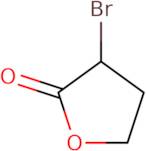a-Bromo-γ-butyrolactone
CAS: 5061-21-2
Rif. 3D-FB04489
| 25g | Fuori produzione | ||
| 50g | Fuori produzione | ||
| 100g | Fuori produzione | ||
| 250g | Fuori produzione | ||
| 500g | Fuori produzione |
Informazioni sul prodotto
- 2-Bromo-4-hydroxybutyric acid-gamma-lactone
- (3R)-3-bromodihydrofuran-2(3H)-one
- (3S)-3-bromodihydrofuran-2(3H)-one
- 2(3H)-Furanone, 3-bromodihydro-
- 2-Bromo-4-Butanolide
- 2-Bromo-4-butyrolactone
- 2-Bromo-4-hydroxybutyric acid g-lactone
- 2-Bromo-4-hydroxybutyric acid gamma-lactone
- 2-Bromo-gamma-butyrolactone
- 2-Bromo-γ-butyrolactone
- Vedi altri sinonimi
- 3-Bromo-2-oxotetrahydrofuran
- 3-Bromo-4,5-dihydro-2(3H)-furanone
- 3-Bromodihydro-2(3H)-furanone
- 3-Bromooxolan-2-one
- 3-Bromotetrahydrofuran-2-one
- 3-bromodihydrofuran-2(3H)-one
- Butyric acid, 2-bromo-4-hydroxy-, γ-lactone
- Butyric acid, α-bromo-γ-hydroxy-, γ-lactone
- NSC 11726
- NSC 56959
- a-Bromo-γ-butyrolatone
- alfa-Bromo-gamma butyrolatone
- Α-Bromo-R-Butyrolactone
- α-Bromo-γ-butyrolactone
- α-Bromobutyric acid γ-lactone
a-Bromo-gamma-butyrolactone (BBAL) is a structural analog of gamma-hydroxybutyric acid, a drug used to treat narcolepsy and cataplexy. BBAL can be synthesized by reacting anhydrous sodium with a mixture of bromoacetic acid and acrylonitrile in the presence of potassium hydroxide. The reaction mechanism for this process is not fully understood but it is believed that a tautomerization may occur between the two possible structures: alpha and beta. This product has been shown to provide pain relief in animal models as well as improve symptoms of metabolic disorders such as diabetes mellitus type II.





